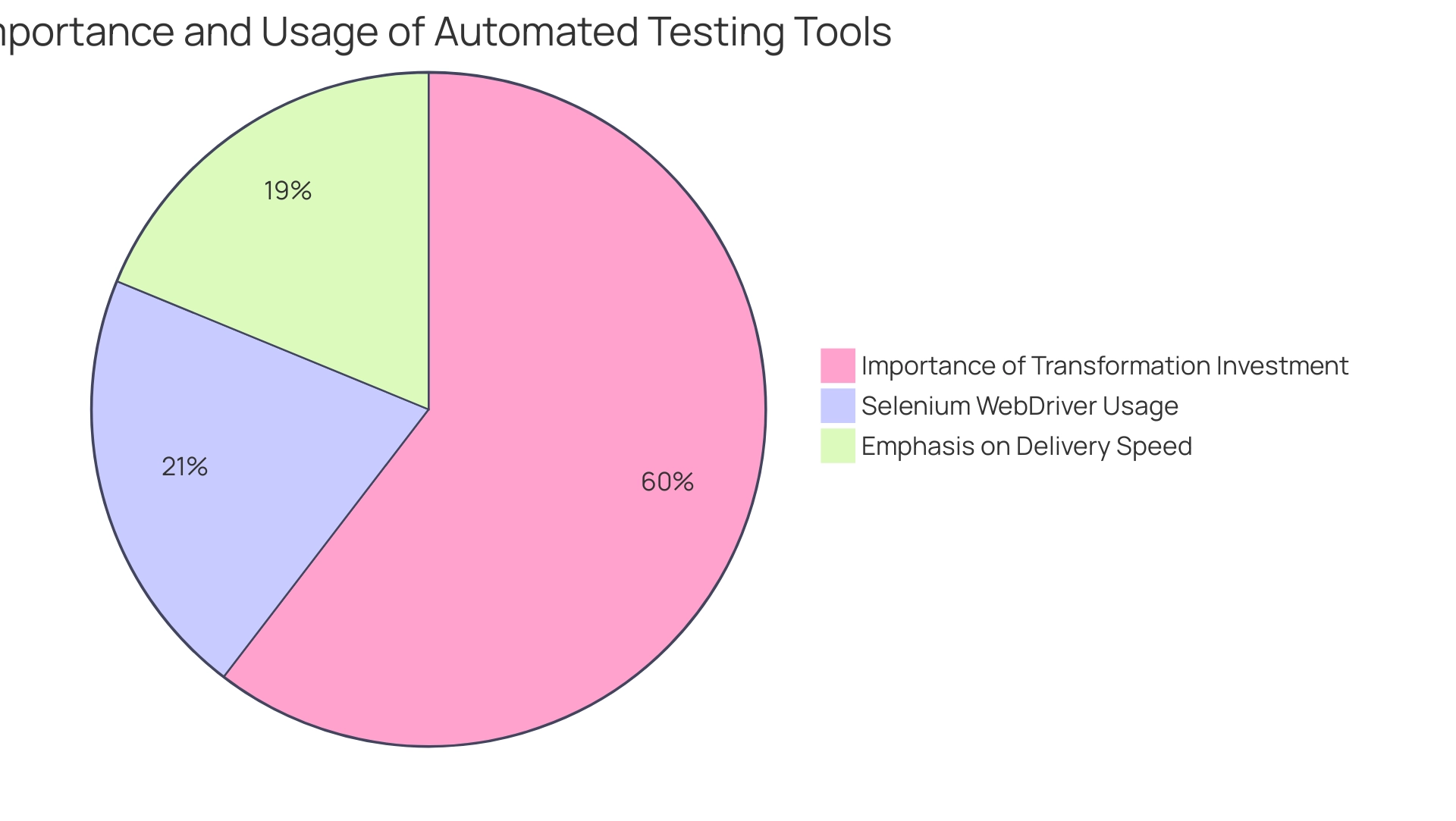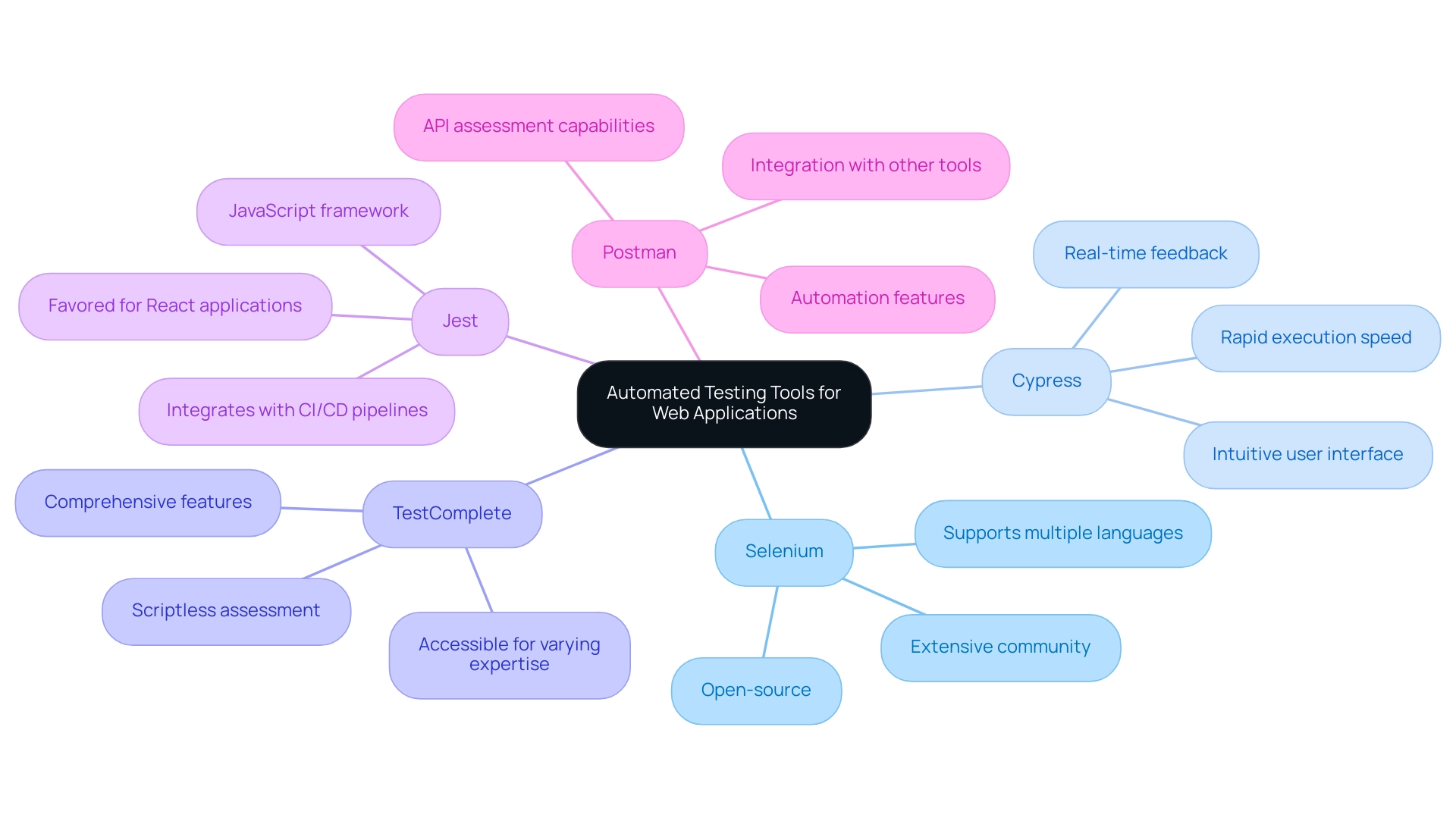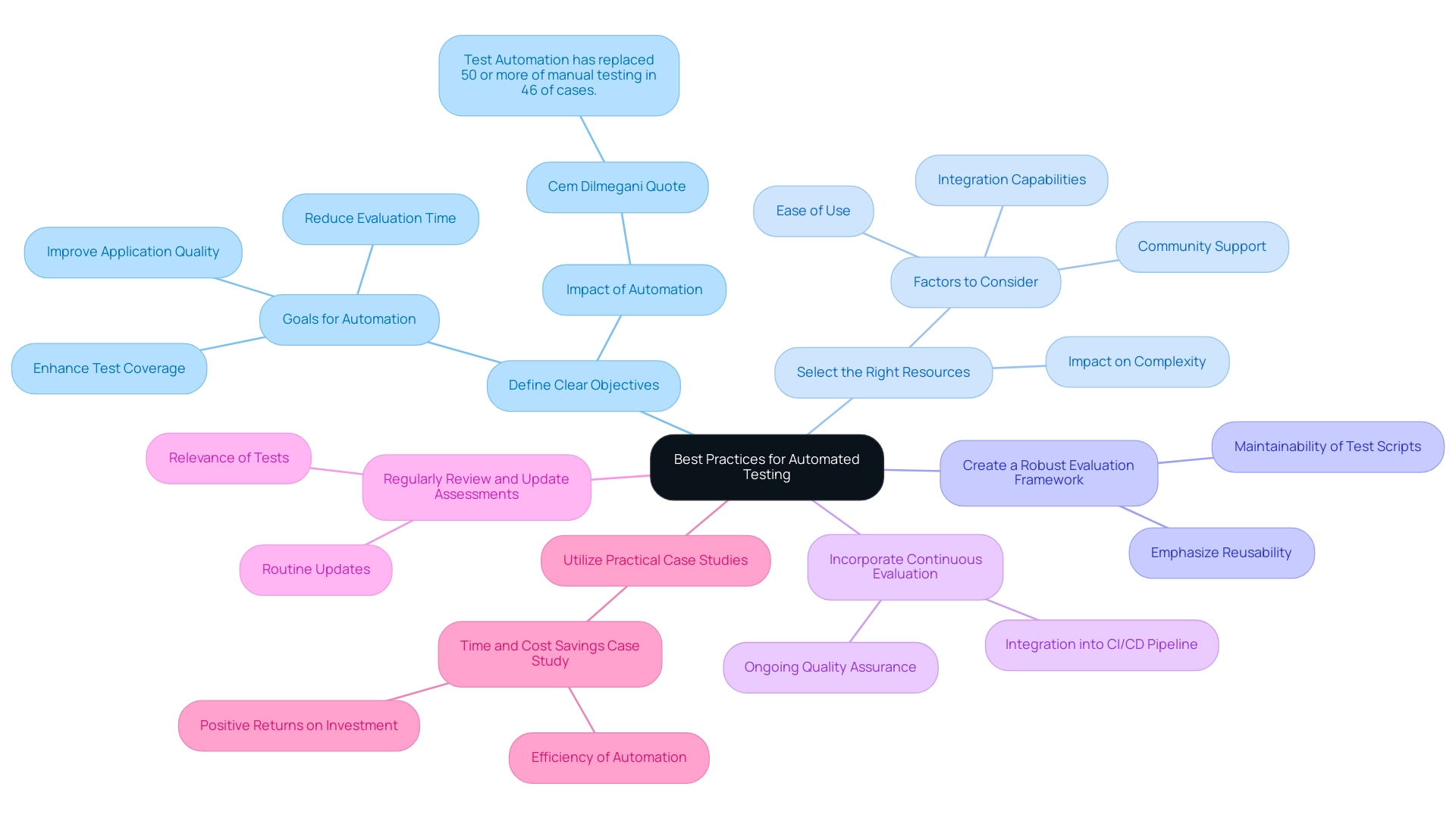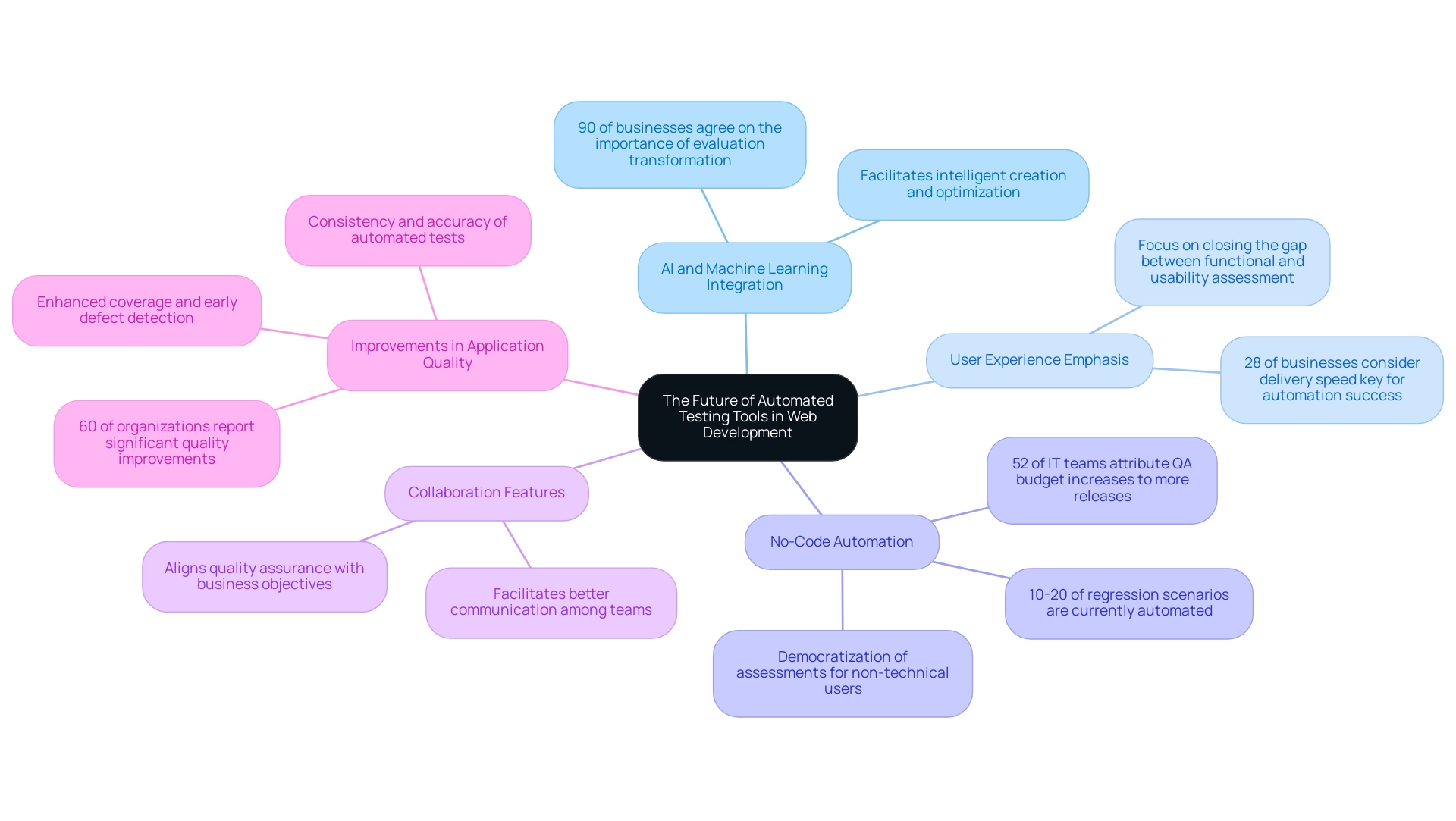Introduction
In the rapidly evolving landscape of web application development, automated testing tools have emerged as essential assets for ensuring quality and efficiency. As organizations strive to deliver seamless user experiences and maintain competitive advantages, the adoption of these tools has become a strategic imperative.
With a staggering 90% of companies acknowledging the critical nature of testing transformation for continuous delivery, the importance of selecting the right automated testing solutions cannot be overstated. From enhancing accuracy to speeding up time-to-market, the benefits are profound.
This article delves into the nuances of automated testing tools, exploring their capabilities, best practices for implementation, and the challenges organizations face while navigating this transformative journey. As the future unfolds, understanding these dynamics will empower development teams to harness the full potential of automation, ultimately leading to superior web applications that meet and exceed user expectations.
Understanding Automated Testing Tools for Web Applications
In the field of web application development, automated test tools for web applications are essential, as they provide a means to simplify evaluation procedures, strengthen precision, and improve overall quality assurance. These automated test tools for web applications empower development teams to automate repetitive tasks, ensuring that applications operate seamlessly across a multitude of scenarios. With 90% of companies acknowledging that investing in transformation is crucial for continuous delivery, it's clear that the stakes are high.
In fact, 31% of businesses utilize Selenium WebDriver as an automation framework, highlighting its role in the industry. The use of automated test tools for web applications not only accelerates time to market but also significantly enhances user experience while mitigating the risks of bugs or performance issues. Significantly, 28% of organizations mention speed of delivery as a key metric for the successful implementation of automated test tools for web applications, highlighting the importance of efficiency in the evaluation process.
As e-commerce businesses navigate the competitive digital landscape, the insights from Ryan Bradshaw resonate strongly:
69.5% of software companies agree that mobile is a critical or at least very important part of their business model.
This highlights the necessity of thorough mobile app evaluation, which is a major and likely enduring aspect of the software assessment landscape, in maintaining a solid online presence and fostering customer engagement. With recent progress in self-operating assessment resources, especially in 2024, companies can utilize automated test tools for web applications to ensure their platforms not only fulfill but surpass user expectations, fostering greater satisfaction and loyalty.

Exploring the Top Automated Testing Tools for Web Applications
The range of automated test tools for web applications is diverse, with each tool providing unique features designed for different assessment needs. Significantly, 90% of firms concur that investing in evaluation transformation is essential for facilitating continuous delivery, emphasizing the crucial role these resources play in contemporary development practices. Among the leading options are:
- Selenium: This widely-used open-source tool excels in functional evaluation, supporting multiple programming languages and browsers, making it a versatile choice for many development teams. Its extensive community and resources further bolster its reliability.
- Cypress: Renowned for its intuitive user interface and rapid execution speed, Cypress stands out in end-to-end evaluation. It offers real-time feedback during assessments, enhancing the debugging process and making it especially attractive for developers.
- TestComplete: As a commercial solution, TestComplete boasts a comprehensive suite of features for functional evaluation, including options for scriptless assessment. This is beneficial for teams with varying levels of programming expertise, allowing broader accessibility in test creation.
- Jest: A popular JavaScript framework for verification, Jest is especially favored for assessing React applications. It integrates seamlessly with CI/CD pipelines, making it an efficient choice for teams adopting continuous integration practices.
- Postman: Mainly an API assessment application, Postman also provides automation capabilities that are essential for evaluating web applications reliant on backend services. Its ability to streamline API evaluations while integrating with other tools makes it a valuable asset in the toolkit.
Furthermore, the case analysis of Quick Base demonstrates the efficiency of cloud-based automated assessments. By utilizing Sauce Labs' cloud-based automated test tools for web applications, Quick Base significantly enhanced efficiency, resulting in quicker evaluation cycles and improved overall productivity in their development process. Choosing the best assessment instrument necessitates thoughtful evaluation of the application’s particular requirements, the team's proficiency, and financial constraints. A strategic method for choosing instruments can greatly influence the efficiency and effectiveness of the evaluation process. As Katalon states, '90% of companies agree or strongly agree that investing in transformation is critical to enabling continuous delivery,' reinforcing the significance of these tools in achieving operational excellence.

Best Practices for Implementing Automated Testing
To efficiently apply machine-driven evaluations in your web application development, consider the following best practices:
-
Define Clear Objectives: It is crucial to establish specific goals for your automated assessment efforts. Whether your aim is to significantly reduce evaluation time, enhance test coverage, or improve overall application quality, clear objectives will guide your strategy. As Cem Dilmegani notes,
Test Automation has replaced 50% or more of the manual testing efforts in 46% of the cases,
underscoring the transformative impact of automation on efficiency. -
Select the Right Resources: Choosing instruments that align with your development stack and team's expertise is vital. Consider factors such as ease of use, community support, and integration capabilities, as these will directly impact the complexity of creating and executing evaluations. The right tools can streamline your processes and enhance productivity.
-
Create a Robust Evaluation Framework: Design an evaluation framework that emphasizes reusability and maintainability of test scripts. This method not only saves time but also ensures that your evaluation efforts remain effective as your application evolves.
-
Incorporate Continuous Evaluation: Integrating automated assessments into your CI/CD pipeline is essential for maintaining a rapid development pace. Continuous evaluation enables frequent execution of assessments, ensuring that quality assurance remains an ongoing priority throughout the development lifecycle.
-
Regularly Review and Update Assessments: As your application undergoes changes and new features are added, it's important to routinely review and update your evaluation scripts. This practice ensures that your tests remain relevant and effective, thereby maximizing their impact on your quality assurance process.
-
Utilize Practical Case Studies: For example, a case study on time and cost savings demonstrates that organizations that have embraced mechanized evaluation have reported significant reductions in evaluation duration and overall expenses. Showing such efficiency not only emphasizes the advantages of automation but also strengthens the case for investing in strong evaluation frameworks.
By following these best practices, development teams can effectively utilize automated test tools for web applications, leading to improved development processes and the delivery of high-quality web applications. Statistics show that 90% of companies acknowledge the significance of investing in evaluations of transformations, which is essential for facilitating continuous delivery, demonstrating a rising trend towards automation in the industry.

Navigating Challenges in Automated Testing Tools
While the benefits of automated test tools for web applications are well-documented, organizations must navigate several related challenges to maximize their effectiveness.
- Initial Setup Costs: The execution of mechanized evaluation frequently necessitates a significant preliminary expenditure on both tools and training. This can be a significant barrier for many organizations, especially for those with tight budgets.
However, it is worth mentioning that companies can receive 100 minutes of automation evaluation minutes free, providing a practical incentive for those considering automated test tools for web applications.
-
Complexity of Maintenance: As applications evolve, the complexity of maintaining scripts tends to escalate, demanding ongoing attention and resources. The intricacies involved can lead to increased maintenance efforts, diverting valuable resources from other critical tasks.
-
Limited Scope of Testing: Automated tests can sometimes fall short in covering all possible scenarios, particularly those related to user experience or visual elements. This limitation may lead to gaps in evaluation, potentially overlooking critical issues that could affect end-user satisfaction.
-
Skill Gaps: A lack of familiarity with automated test tools for web applications can hinder teams, necessitating additional training to bridge these skill gaps. This requirement can create further delays in implementation, as teams work to acquire the necessary expertise.
Research indicates that less than 50% of companies currently utilize AI capabilities in automation. This presents a unique opportunity for organizations to enhance their efficiency and remain competitive in an increasingly sophisticated technological landscape.
According to Sandeep CH, the US test automation market is projected to grow at a 1.5% CAGR from 2022 to 2032, highlighting the ongoing significance of mechanized evaluation. This growth highlights the importance of addressing the challenges to fully capitalize on the benefits of automated test tools for web applications.
Additionally, a case study shows that 44% of developers utilize Continuous Integration/Continuous Delivery (CI/CD) tools to enable faster delivery and ongoing evaluation. This real-world example demonstrates how organizations can effectively manage the challenges of system evaluation implementation. By acknowledging these challenges, organizations can create effective strategies to reduce risks linked to system evaluations, ensuring a smoother transition and more successful outcomes in their quality assurance processes.

The Future of Automated Testing Tools in Web Development
The environment of automated assessment resources is experiencing notable change, propelled by various essential trends that are redefining web development approaches:
-
AI and Machine Learning Integration: The future of evaluation is progressively dependent on AI and machine learning, which improve evaluation capabilities by facilitating more intelligent creation and optimization. This represents more than merely a technological progress; 90% of businesses concur that investing in evaluation transformation is essential for facilitating continuous delivery, as highlighted by Katalon.
-
Enhanced Emphasis on User Experience: Upcoming automation resources are anticipated to prioritize user experience, closing the divide between functional and usability assessment. This change is vital, as 28% of businesses recognize delivery speed as an important measure for effective implementation of automated test tools for web applications, emphasizing the need for resources that guarantee rapid and user-focused evaluation processes.
-
Rise of No-Code Automation: As the demand for automation increases, no-code solutions are poised to emerge, enabling non-technical users to create and manage assessments without extensive coding expertise. This democratization of assessments is crucial, given that only 10-20% of regression scenarios are presently mechanized across the industry, highlighting a notable chance for enhancement. Additionally, 52% of IT teams credit the boost in QA budgets to the growing number of releases, underscoring the increasing investment in automated test tools for web applications.
-
Enhanced Collaboration Features: The incorporation of collaboration features in automated test tools for web applications will facilitate better communication among development, testing, and marketing teams. This is vital for ensuring that quality assurance aligns seamlessly with broader business objectives.
Organizations that stay informed about these trends will be better positioned to maintain a competitive edge in their digital marketing efforts and e-commerce strategies. Notably, 60% of organizations using automated test tools for web applications report significant improvements in application quality due to enhanced coverage and early defect detection, as seen in the case study titled 'Improvements in Application Quality,' which highlights the consistency and accuracy of automated test tools for web applications contributing to these quality improvements. This underscores the tangible benefits of staying ahead in this evolving landscape.

Conclusion
The exploration of automated testing tools reveals their indispensable role in web application development. By streamlining testing processes and enhancing accuracy, these tools are crucial for organizations striving for efficiency and quality assurance. With a significant percentage of companies recognizing the necessity of testing transformation, it is evident that investing in the right automated testing solutions is vital for maintaining competitiveness and delivering exceptional user experiences.
The diverse landscape of automated testing tools, including popular options like Selenium, Cypress, and TestComplete, offers tailored capabilities to meet various testing needs. Best practices for implementation, such as:
- Defining clear objectives
- Integrating continuous testing
can significantly enhance the effectiveness of these tools. However, organizations must also navigate challenges, including:
- Initial setup costs
- The complexity of maintaining test scripts
to fully leverage the benefits of automation.
Looking ahead, the integration of AI and machine learning stands to revolutionize automated testing, while a focus on user experience and the rise of no-code solutions will democratize testing efforts across teams. By addressing current challenges and staying informed about emerging trends, organizations can harness the full potential of automated testing tools, ultimately leading to superior web applications that not only meet but exceed user expectations. Embracing these innovations will be key to driving quality and efficiency in the fast-paced digital landscape.





